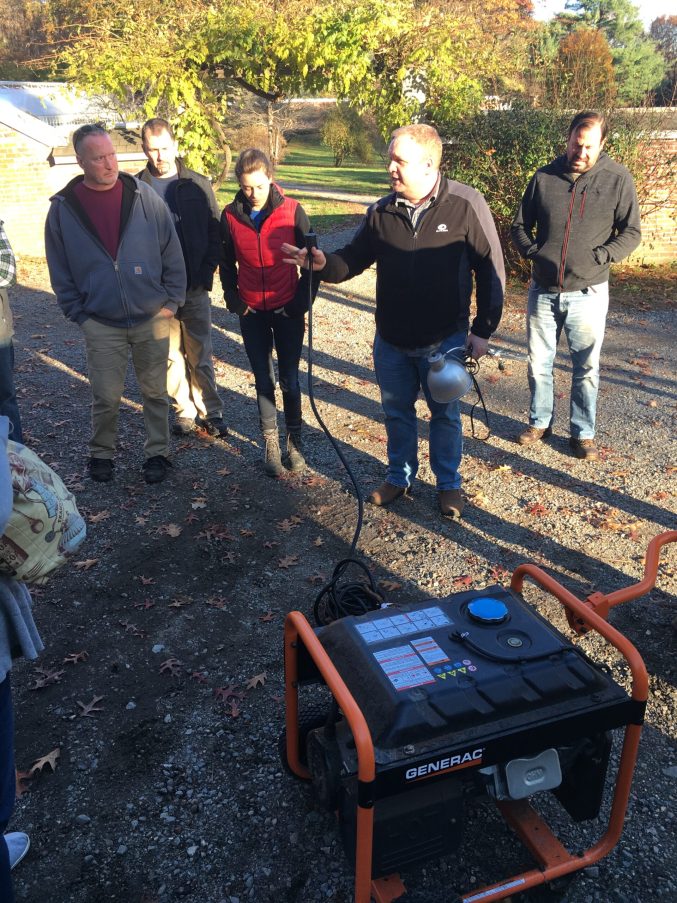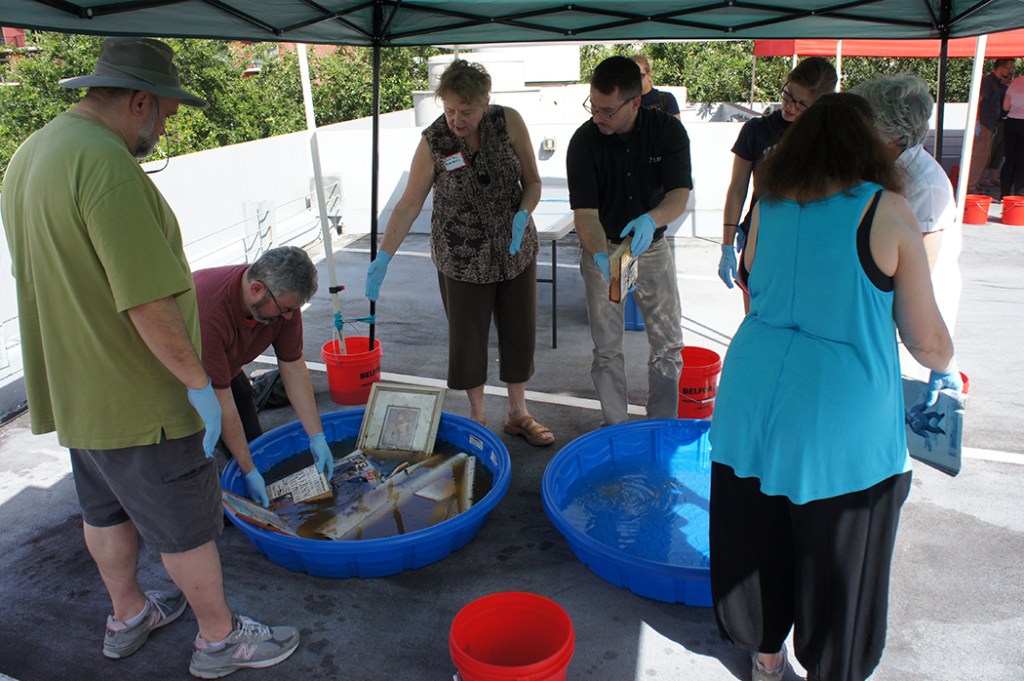
It’s a Thursday afternoon in July and the Museo de Arte de Puerto Rico (MAPR) is almost empty. Director Marta Mabel Pérez is in her office, leading a virtual hub of staff and other professionals through crisis management, reopening protocols, and plans for the future. She has faced the devastation of the 2017 hurricanes and recent earthquakes. Now she is busy supporting her employees, ensuring her museum complies with new health and safety regulations, and encouraging the territory to formally integrate heritage protection into its COVID-19 response.
Meanwhile in Texas, Steve Pine, a decorative arts conservator at the Museum of Fine Arts, Houston (MFAH), says all staff who can work remotely do. Those on the premises must wear masks and physically distance. When distancing is difficult in shared spaces, staff split work weeks on-site and from home, just one of many strategies the museum developed to help keep them safe while continuing their important work. Pine is involved with the statewide heritage emergency network TX-CERA, Texas Collections Emergency Resource Alliance, making Texas hurricane-ready. Now he focuses on collaborating with local networks to battle the crisis facing all museums and sharing information on new best practices.
Finally, on the East Coast, Ben Haavik is responsible for the maintenance and preservation of thirty-seven historic house museums and landscapes for Historic New England, the oldest and largest regional heritage organization in the nation. He champions emergency preparedness and oversees response after one of New England’s famous storms damages a tree or floods one of the homes. Now, his job includes integrating safety guidance for COVID-19 from five different states and twenty-two different towns.
We recently sat down with these three veteran disaster risk managers to brainstorm about planning for weather emergencies amid the new normal. As we spoke to them, their institutions were in different stages of reopening: The MAPR had a soft reopening in mid-July for members, the MFAH re-opened in mid-May, and Historic New England reopened six of its thirty-seven sites in mid-July but has no intentions of opening the remainder this year.
Skip over related stories to continue reading articleWhile fortunately none of them has experienced a hurricane this season, two named storms did pass through as near misses, prompting them to review their disaster plans. In some cases, this meant amending timetables to avoid people clustering together to document and move objects, in others it meant enlisting the museum’s building engineer and management company to secure the building, with training on collections care delivered over WhatsApp and videoconferencing.
New Challenges for Hurricane Preparedness
COVID-19 has added a new layer of complexity to the time-consuming process of hurricane preparedness: protecting the health of all involved. This makes it harder to enact “the usual” response to a natural disaster. “We do storms all the time—big storms, small storms, trees down, buildings damaged, and collections damaged. It happens. This was so different,” Haavik says. “We were in uncharted territory. It’s personal health. I can quantify building and landscape damage and whether it’s risky or not. I couldn’t quantify this.”
As we figure out how to integrate COVID-19 considerations into hurricane readiness planning, there are three primary areas to consider:
- People: Who can enter the building after a disaster?
- Preparation: How do you make the work environment safe when the entire community is subject to the demands of the pandemic?
- Operations: What strategies will not only help maintain but also improve the resilience and stability of the organization in this new normal?
People

Normally, hurricane preparedness and response at a cultural institution is an all-hands-on-deck affair. In the past, Haavik noted, “if you had a hurricane hit and someone was sick, they would still probably report to work and help you clean up afterwards. It is a much different environment today.”
Now, people are worried about keeping themselves safe—and about being contagious themselves. This changes the dynamic of how organizations, setting staff well-being as the highest priority, can operate during an emergency.
Overcoming a staffing plan change is one concern. Primary and back-up staff could be ill or need to take the place of someone who is ill. Another concern: how to disseminate “situational awareness” and up-to-date information widely within the organization, so that those available can take on the response roles needed.
One strategy all the experts said they would consider is deploying professional resources inside and outside the organization differently. Here are some possible approaches:
- Begin to think of your organization as a regional entity. Learn who else is working on hurricane readiness and get to know them before the disaster. Then you will have the option of calling on other professionals outside the impact zone with different expertise for advice or potential help in the impact zone.
- Share your emergency response plan widely within your organization, encouraging staff to become familiar with it. Make sure everyone understands their role and the roles of others. Practice the plan and implement cross-training to fill any gaps and build capacity in critical areas.
- Look beyond your immediate staff and incorporate affiliated people who are already protecting the building. This should include special training that pairs these colleagues with collections professionals.
Preparation
Preparation for the next crisis is never far from the thoughts of people who protect the patrimony of their communities. In Puerto Rico, which faces multiple threats, Pérez and her staff have regular dedicated meetings to prepare for extreme natural events—not only hurricanes, but also COVID-19, earthquakes, and even fireballs (or meteorites, which actually occurred in January 2020). At these meetings, Pérez says, “We review the whole plan for what we have to do, how we have to react, and who we have to train.”
This moment makes preparation more difficult, with multiple layers of emergency to plan for. All three institutions concurrently have health and safety protocols to develop, personal protective equipment (PPE) to stock, and emergency plans to review and adapt. To consolidate some of this planning, adaptive practices could include the following:
- Mandate health protocols, including safe physical distancing, face coverings for those working in close quarters, and N95 masks when mold has bloomed. Assign tasks on alternating schedules so that multiple people don’t have to work in the same small confined space. Create a protocol for cleaning the space upon arrival and departure, and have each staff member use their own set of instruments, from clipboards and pencils to small hand tools.
- Since PPE is a basic requirement for salvaging and moving objects following a disaster, consider how the equipment the institution is purchasing for reopening can be repurposed for hurricane response.
- Create a protocol for those engaged in response and salvage to stop performing a task if they don’t feel comfortable doing it, so that they feel protected.
- Consider how to deploy a local emergency network, whose members, trained in disaster response, can provide a reassuring level of competence and trust.

Operations
As staff learn how to return to work safely, the most basic museum functions are shifting. Every day brings a new challenge: issues like building management, the place of culture in emergency management agency plans, or updating the institution’s disaster plan.
The three museums have all experienced this. Haavik is already on version eight of a COVID-19 safety plan he made with his staff, as the situation continually evolves. Pine, when asked about updating the MFAH disaster plan to incorporate pandemic response, says he would like to enhance PPE and have teams remain as units throughout preparation and recovery, thus limiting the number of staff needing to quarantine should one member develop symptoms and require COVID testing. Pérez is relying on the procedures she worked with the Smithsonian Cultural Rescue Initiative (SCRI) and HENTF to develop after the two 2017 hurricanes. She says, “We have all the training that you [SCRI and HENTF] gave us. We have all the collections logged and we are prepared. Now it is not only the collections staff but everyone in the museum that needs to be trained.”
Best practices to develop as part of regular operations could include the following:
- Develop a solid relationship with local first responders before disaster strikes. Understanding each other’s priorities in the face of disaster and learning how to work together to protect your valuable and vulnerable collections starts with building that relationship.
- Seek opportunities that work in the context of your community to tell your story to those who make the decisions.
While all of our experts agree that disaster plans must be updated to incorporate response to a pandemic, they are not yet ready to formalize any action steps; they are still trying to navigate the unknown as best they can. In time, they will pursue thoughtful planning and revisions. For now, they will continue to document their actions and activities so they can look back—at some point—and gauge what worked and what didn’t.
The Future of Hurricane Readiness
We asked each of our experts what they would most like to share about past experiences in preparing for major storms.
Pine says the keys are preparation and networking. Institutions are stronger together, he believes, and no organization should have to do this alone. Networking also gives you access to talent and experience that you might not have. He has confidence in the Alliance for Response, a local-network model and program of FAIC, which fosters connections between cultural stewards and the local emergency management community, from firefighters to healthcare workers. “Being aware of ways to find paths and connectivity to that community is going to make the preparation so much better informed and the response so much more successful,” Pine says.
Pérez emphasizes the importance of cross-training staff. She prefers to work with everyone at her institution rather than using a hierarchical approach. This ensures that everyone knows exactly what to do in an emergency. She says it is vital to identify who will coordinate the response for you, choosing a person who has the intuition and knowledge to make decisions in a changing environment. She is a strong supporter of ACE PR, Alianza Cultural para Emergencias de Puerto Rico, the heritage emergency network formed after the 2017 hurricanes that can assist cultural institutions before and after disasters. Integrating museum professionals into local and, in her case, territorial emergency management planning is also a key step. The way forward is to convince decision makers that “taking care of collections is an essential function to save patrimony,” says Pérez.
Haavik agrees with the importance of networking. There are always going to be emergencies, and involvement with a statewide coalition can help ensure a coordinated and effective response. He belongs to the statewide network COSTEP MA, Coordinated Statewide Emergency Preparedness in Massachusetts. He also encourages a post-response review of actions undertaken. The goal, he says, is to respond better at the next emergency, to look for the things you can change while understanding that you can’t do everything. Incremental growth in expertise is a sign of progress. “For me,” he says, “it was looking at major tree damage after storms. We started investing in tree care and now we don’t have to clean up as many trees.”
Thinking about hurricane readiness during the pandemic can feel overwhelming. However, you don’t have to do it alone. Connecting with heritage networks and exchanging ideas with colleagues boosts your ability to adapt and respond. Strong planning and communication among staff provide confidence to implement the emergency plan and contribute to the resilience of the organization.








Comments